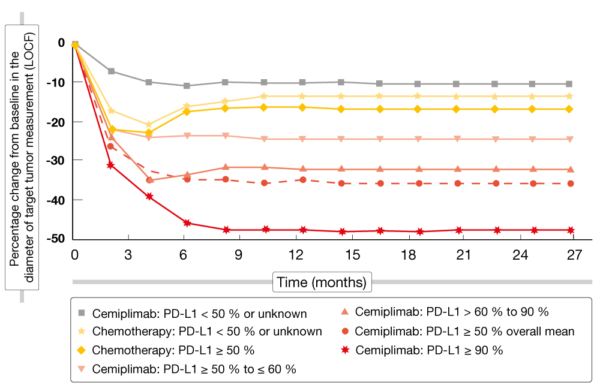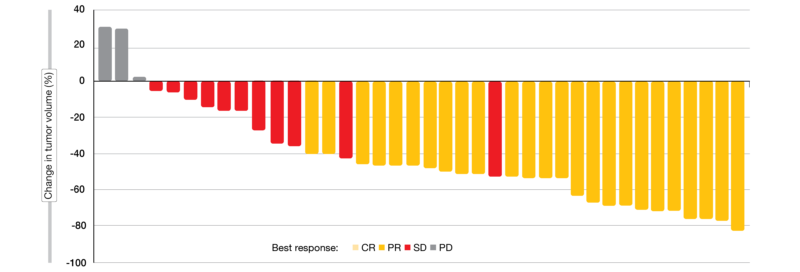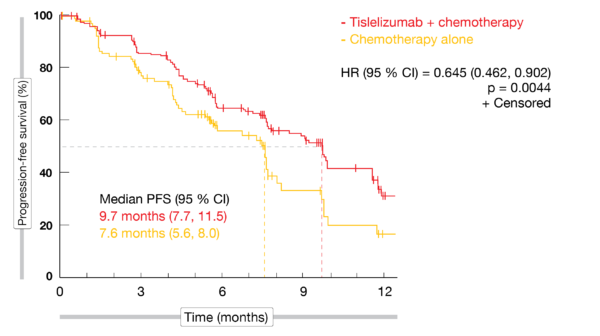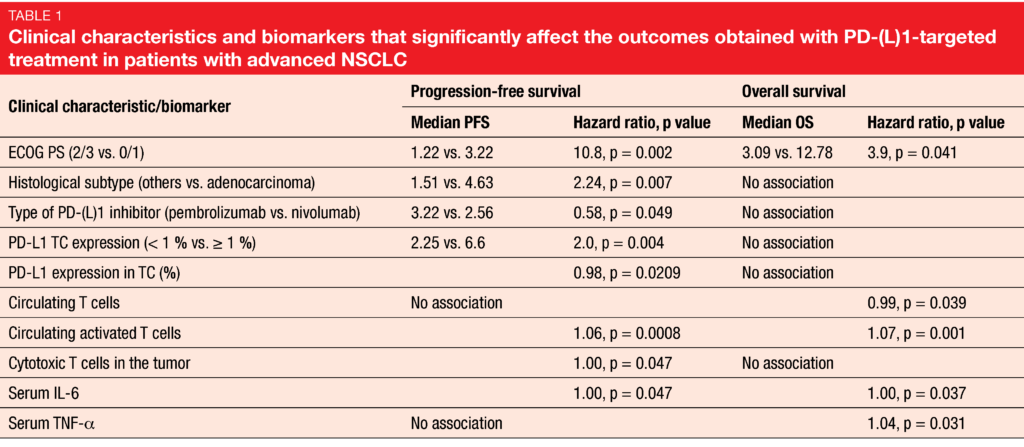Immune checkpoint inhibition: chemotherapy-free regimens & new PD-1 inhibitors on the horizon
Monotherapy versus chemotherapy
Five-year update of KEYNOTE-024
Pembrolizumab as single agent for up to 35 cycles has been shown to be superior to 4 to 6 cycles of platinum-doublet chemotherapy in patients with metastatic non–small-cell lung cancer (NSCLC) and a PD-L1 tumor proportion score (TPS) ≥ 50 % in the KEYNOTE-024 trial. At a median follow-up of 11.2 months, median progression-free survival (PFS) was 10.3 vs. 6.0 months (HR, 0.50; p < 0.001), and median overall survival (OS) had not been reached yet in either group, with 80.2 % vs. 72.4 % of patients alive at 6 months (HR, 0.60; p = 0.005) [1]. At the ESMO 2020 Congress, Brahmer et al. reported updated outcomes after a follow-up of 5 years [2]. Pembrolizumab and chemotherapy had been administered in 154 and 151 patients, respectively. The group of 39 patients who had received all of the 35 pembrolizumab cycles was analyzed separately, as were 12 patients who had been treated with a second course of pembrolizumab upon progression.
Pembrolizumab continued to induce meaningful OS improvement in the total group (26.3 vs. 13.4 months; HR, 0.62). Despite the 66 % effective crossover rate, the 5-year OS rate was approximately doubled in the experimental arm (31.9 % vs. 16.3 %). Median PFS was 7.7 vs. 5.5 months, with 22.8 % vs. 4.1 % of patients being progression-free at 36 months. Objective responses occurred in 46.1 % and 31.1 %, respectively. Seven pembrolizumab-treated patients (4.5 %) experienced complete remissions (vs. 0 % in the chemotherapy arm). Duration of response was 29.1 vs. 6.3 months. The group of 39 patients who had received 35 cycles of pembrolizumab experienced long-term OS. At data cutoff, 46 % were alive without disease progression or subsequent therapy. The 3-year OS rate from completion of treatment was 81 %, and objective responses had occurred in 82 %. Four patients (10 %) showed complete remissions. One patient developed a secondary malignancy and was treated accordingly.
Also, second-course pembrolizumab proved feasible and was associated with anti-tumor activity. Here, the objective response rate (ORR) during the second course amounted to 33 %, and 42 % of patients were alive without disease progression at data cutoff. Twenty-five percent of these received no subsequent treatment. The long-term administration did not give rise to new safety signals. Patients in the experimental arm developed less frequently any-grade and grade 3 to 5 treatment-related AEs than those in the control arm. Overall, these data confirmed the 5-year OS outcomes among previously untreated patients included in the single-arm KEYNOTE-001 study [3]. KEYNOTE-024 is the first phase III trial to show 5-year efficacy for first-line immunotherapy, demonstrating that pembrolizumab monotherapy is an active first-line regimen in patients with metastatic NSCLC and PD-L1 TPS ≥ 50 %.
Cemiplimab in lung cancer: EMPOWER-Lung 1
A new first-line monotherapy option is the anti-PD-1 antibody cemiplimab that has already been widely approved for the treatment of cutaneous squamous cell carcinoma. Sezer et al. presented the second pre-specified interim analysis of the randomized phase III EMPOWER-Lung 1 study that compared cemiplimab monotherapy with platinum-doublet chemotherapy according to investigators’ choice in untreated patients with advanced NSCLC and PD-L1 expression ≥ 50 % [4]. In the ITT population, 356 and 354 patients were randomized to cemiplimab 350 mg three-weekly (Q3W) and 4 to 6 cycles of chemotherapy, respectively. The PD-L1 ≥ 50 % ITT population consisted of 563 patients, with 283 and 280 receiving cemiplimab and chemotherapy, respectively. OS and PFS were defined as coprimary endpoints.
EMPOWER-Lung 1 met its primary and secondary endpoints. In the PD-L1 ≥ 50 % ITT population, the mortality risk was reduced by 43 % (median OS, not reached vs. 14.2 months; HR, 0.57; p = 0.0002), and the risk of progression and death decreased by 46 % (median PFS, 8.2 vs. 5.7 months; HR, 0.54; p < 0.0001). At 12 months, 72.4 % vs. 53.9 % of patients were alive, and 40.7 % vs. 7.1 % were progression-free. The significant OS benefit was achieved despite a high crossover rate of 74 %. ORRs were 39.2 % vs. 20.4 %, with responses lasting longer in the experimental arm (16.7 vs. 6.0 months). Increasing PD-L1 expression levels correlated with better outcomes in the cemiplimab-treated group; this was true with respect to changes in target tumor volume (Figure 1), ORR, OS and PFS. No such correlations were seen for chemotherapy.
With regard to global health status and health-related quality of life, cemiplimab was shown to induce early improvement that increased over time, while patients treated with chemotherapy fared worse from the beginning and eventually deteriorated. Although exposure to cemiplimab was substantially longer than exposure to chemotherapy, a favorable safety profile of the PD-1 inhibitor was observed, with considerably lower rates of hematological and non-hematological adverse events (AEs). Immune-related AEs led to discontinuation in 2.5 %. As the authors summarized, these data provide the rationale for cemiplimab as a new first-line monotherapy option for patients with advanced NSCLC and PD-L1 expression ≥ 50 %.
Figure 1: Correlation of changes in target tumor volume with baseline PD-L1 levels in patients receiving either cemiplimab or chemotherapy
Immunotherapy plus anti-angiogenesis
Nivolumab-based regimen
Combination therapies of checkpoint inhibitors, cytotoxic chemotherapy and anti-angiogenic treatment are assumed to exert synergistic effects. In the IMpower150 study, atezolizumab has shown efficacy together with chemotherapy and bevacizumab as first-line therapy for patients with advanced NSCLC [5]. Therefore, the randomized phase III ONO-4538-52/TASUKI-52 trial evaluated nivolumab 360 mg Q3W plus carboplatin/paclitaxel and bevacizumab in a treatment-naïve PD-L1 all-comer population with stage IIIB/IV non-squamous NSCLC. In the control arm, placebo was administered in addition to the chemotherapy doublet and bevacizumab. Each arm contained 275 patients.
Regarding PFS, which was defined as the primary endpoint, the interim analysis presented at ESMO 2020 demonstrated superiority of the nivolumab-based regimen (12.1 vs. 8.1 months; HR, 0.56; p < 0.0001) [6]. The 12-month PFS rates were 50.1 % and 30.2 % for the two arms. Almost all subgroups derived PFS benefits from the addition of nivolumab. Notably, PD-L1 expression did not affect the outcomes. However, median OS did not differ across the two arms (25.4 vs. 24.7 months; HR, 0.85). No new safety signals were detected in the experimental group. The authors noted that the addition of nivolumab to first-line chemotherapy and bevacizumab induces a significant and clinically meaningful PFS improvement, providing a potential new standard of care for these patients.
Atezolizumab plus bevacizumab
In patients with high PD-L1 expression, a chemotherapy-free regimen of atezolizumab plus bevacizumab might be sufficient to elicit substantial effects. The phase II, single-arm, open-label, multi-institutional WJOG @Be Study tested this combination in an untreated population of 39 patients with advanced non-squamous NSCLC and PD-L1 TPS ≥ 50 % [7]. Atezolizumab was administered at a dose of 1,200 mg together with bevacizumab 15 mg/kg Q3W for up to 2 years. ORR constituted the primary outcome.
Overall, 64.1 % of patients developed complete or partial responses, with almost all of them experiencing tumor shrinkage (Figure 2). Median PFS was 15.9 months. At 12 months, 70.6 % of patients were alive, 48.2 % showed responses, and 54.9 % were progression-free. Median duration of response was 10.4 months. At the time of the data cutoff, half of the population was still receiving the study treatment. Unexpected AEs did not occur, and no grade 4/5 events were observed. Two patients discontinued treatment due to toxicity. As confirmatory evidence is called for, atezolizumab plus bevacizumab will be compared with the IMpower150 regimen and atezolizumab monotherapy in the 3-arm, phase III @Be-F1rst study.
Figure 2: Atezolizumab plus bevacizumab: tumor shrinkage in almost all patients
Phase III results for emerging PD-1 inhibitors
Tislelizumab: pivotal phase III study
New PD-1 inhibitors are being developed, among them tislelizumab that was designed to minimize binding to FcγR on macrophages. This mechanism abrogates antibody‑dependent phagocytosis, which is a potential mechanism of T cell clearance and resistance to anti-PD-1 therapy [8, 9]. Three early-phase studies (BGB-A317-001, BGB-A317-102, BGB-A317-206) showed that tislelizumab, as a single agent and in combination with chemotherapy, was generally well tolerated and demonstrated antitumor activity in Asian and non-Asian populations with solid tumors including advanced lung cancers [10-12].
In the phase III setting, the open‑label, multicenter, randomized RATIONALE 304 study investigated tislelizumab 200 mg Q3W combined with pemetrexed plus cisplatin or carboplatin (n = 223) versus chemotherapy alone (n = 111) as first‑line treatment in patients with stage IIIB/IV non-squamous NSCLC [13]. After induction that comprised 4-6 cycles, the maintenance phase included three-weekly treatment with tislelizumab 200 mg plus pemetrexed 500 mg/m2 in the experimental arm and pemetrexed monotherapy in the control arm. Forty-seven sites in China participated in the trial.
The addition of tislelizumab gave rise to a significant improvement in PFS (9.7 vs. 7.6 months; HR, 0.645; p = 0.0044; Figure 3) as well as higher ORR (57.4 % vs. 36.9 %) and longer duration of response (8.5 vs. 6.0 months). Consistent PFS benefits were observed across most prespecified subgroups. Median OS had not been reached yet in either arm. The tislelizumab-based regimen was generally well tolerated, with most AEs being mild or moderate and manageable. Most commonly, cytopenias were reported, followed by nausea and elevated transaminases. Immune-mediated AEs occurred in 25.7 % of patients in the experimental arm; these primarily included pneumonitis (9.0 %), hypothyroidism (8.6 %), and hyperthyroidism (2.7 %). Most of them were mild to moderate in severity. Overall, these findings support tislelizumab in combination with platinum-based doublet chemotherapy as a potential new standard first-line treatment of patients with advanced non-squamous NSCLC.
Figure 3: Progression-free survival with tislelizumab plus chemotherapy compared to chemotherapy
Activity in squamous NSCLC
The pivotal, open-label, three-arm, phase III RATIONALE 307 trial conducted in China tested the addition of tislelizumab to paclitaxel/carboplatin or nab-paclitaxel/carboplatin in patients with stage IIIB/IV squamous NSCLC. Results presented at the ASCO 2020 Congress showed that compared to chemotherapy alone, tislelizumab plus chemotherapy Q3W gave rise to significantly improved PFS, ORR and duration of response [14]. An updated analysis of the study including assessment of the clinical significance of blood tumor mutational burden (bTMB) was reported at the ESMO 2020 Congress [15].
Median PFS was 7.6 months for both tislelizumab plus paclitaxel/carboplatin (Arm A) and tislelizumab plus nab-paclitaxel/carboplatin (Arm B) and was thus significantly superior to the PFS obtained with paclitaxel/carboplatin (Arm C; 5.5 months), with risk reductions of approximately 50 % (HR, 0.524; p = 0.0001 and HR, 0.478; p < 0.0001, respectively). The PFS benefits observed with both tislelizumab-based regimens were consistent across all subgroups including PD-L1 expression cohorts. ORRs were 73 % and 75 % in Arms A and B, respectively, vs. 50 % in Arm C. Tislelizumab plus chemotherapy evoked higher response rates irrespective of PD-L1 expression status. Median OS had not been reached yet.
The exploratory analysis of bTMB showed that tislelizumab plus chemotherapy demonstrated ORR and PFS benefits compared to chemotherapy in patients with both bTMB‑high (i.e., ≥ 6 mutations/Mb) and bTMB-low (< 6 mutations/Mb) status. Clinical utility of bTMB as a predictive marker for PFS in the tislelizumab plus chemotherapy arms appeared to be limited according to the interactive analysis. The incidence of treatment-emergent AEs (TEAEs) including grade ≥ 3 events was similar across the arms. Most AEs were mild or moderate and manageable. The authors concluded that these results obtained in patients with squamous lung cancer address a high unmet need. The data support tislelizumab plus paclitaxel/carboplatin or nab-paclitaxel/carboplatin as a potential standard for first-line treatment of advanced squamous NSCLC.
ORIENT trials: sintilimab
Sintilimab, another new anti-PD-1 antibody, is also being evaluated in the phase III setting in both squamous and non-squamous NSCLC. In patients with advanced lung cancer of squamous histology, the randomized, double-blind, phase III ORIENT-12 trial demonstrated favorable findings with first-line sintilimab plus gemcitabine and cisplatin or carboplatin [16]. Patients with stage IIIB/C disease ineligible for surgery/local therapy or stage IV disease participated in the study regardless of their PD-L1 expression status. They were randomized to either sintilimab plus chemotherapy (n = 179) or placebo plus chemotherapy (n = 178) for 4 or 6 cycles. PFS according to independent radiologic review committee was defined as the primary endpoint.
Compared to chemotherapy only, the combination significantly improved PFS (5.5 vs. 4.9 months; HR, 0.536; p < 0.00001). OS was not mature yet, although the preliminary results suggested an advantage in the experimental arm (HR, 0.567; p = 0.01701). Objective responses occurred in 44.7 % vs. 35.4 %, and disease control was achieved in 86.0 % vs. 80.3 %. The two regimens did not differ in terms of TEAEs, grade 3 to 5 TEAEs, and AEs leading to treatment interruption or withdrawal.
In patients with advanced non-squamous NSCLC, the superiority of sintilimab plus chemotherapy (pemetrexed and cisplatin or carboplatin) over placebo plus chemotherapy has been established by the randomized phase III ORIENT-11 study [17]. Median PFS was 8.9 vs. 5.0 months for the two regimens (HR, 0.482). In their analysis presented at ESMO 2020, Yang et al. identified the major histocompatibility complex (MHC)-II antigen presentation pathway as predictive for the activity of this combination [18]. The signature score of this pathway was significantly associated with clinical efficacy, as were representative genes such as HLA-B, HLA-DMB, B2M and CIITA.
Advancing insights into predictive biomarkers
The PIONeer Project
Approximately 30 % and 50 % of first-line and second-line patients, respectively, progress within the first 6 months after initiation of immune checkpoint inhibition. Given the lack of biomarkers to predict these events, the PIONeer Project is dedicated to improving the understanding and prediction of resistance to PD-(L)1-targeted treatment of patients with advanced NSCLC. It consists of the PIONeeR Biomarkers study and the PIONeeR umbrella trial that will test various targeted inhibitors in combination with durvalumab. Barlesi et al. presented results for the first 100 patients included in the PIONeeR Biomarkers study [19].
Biopsies were taken before the initiation of treatment and again at 6 weeks in patients with advanced NSCLC who were receiving PD-(L)1 inhibitors as monotherapy or combined with chemotherapy in the first- and second-line settings. The biomarker program comprises more than 400 biomarkers. These relate to drug response (pharmacokinetic[PK]/pharmacodynamic[PD] modeling), immune cell infiltration, sensitivity to immune effectors (i.e., immune gene expression signatures), immune checkpoints, immune suppression and tumor foreignness (e.g. TMB). Also, peripheral markers include circulating immune cells, soluble markers, endothelial markers, ctDNA, and the microbiome.
Among the first 100 patients included in the biomarker part of the PIONeeR project, the vast majority received treatment in the second line (87 %). As can be expected, the ORR was 13 %, and median PFS and OS were 3.0 and 11.0 months, respectively. The scientists analyzed the predictive power of certain clinical characteristics and biomarkers with respect to these clinical endpoints. None of the clinical characteristics showed a significant association with the probability of objective response, although several biomarkers did (e.g., pretreatment levels of PD-L1–positive tumor cell percentage, cytotoxic T cell CD3+/CD8+ density in the tumor, effective T cell density in the tumor, regulatory T-cell density in the stroma). At 6 weeks, the numbers of neutrophils infiltrating the stroma were also increased in responding patients compared to non-responders.
PS remains the strongest predictor
For PFS, a significant correlation was found with ECOG performance status, histological subtype, the type of treatment and the PD-L1 expression of tumor cells (Table). At the biomarker level, there was an association with PD-L1 expression in tumor cells, circulating activated T cells, serum IL-6, and cytotoxic T cells in the tumor. With respect to OS, the only relevant clinical characteristic was ECOG PS. Among the biomarkers, circulating T cells correlated with the probability of survival, as well as circulating activated cells, serum IL-6, and serum TNF-α.
PD-L1-positive cell density in the tumor was particularly low in specimens of patients who did not respond to treatment despite PD-L1 expression of ≥ 15 % on tumor cells. Also, PD-L1-positive cell density on all cell types (i.e., tumor and stroma cells), when provided with a cutoff of 546 cells/mm2, showed a potent correlation with OS. Other potentially powerful biomarkers were cytotoxic T cells in the tumor and at the tumor-stroma interface.
With regard to PK/PD parameters, a large inter-patient variability existed for both peak and trough levels after exposure to atezolizumab, pembrolizumab and nivolumab. The identification of individual PK parameters and PK/PD modeling is ongoing. Finally, the evolution of the immune profile before and after 6 weeks of treatment is being assessed. This showed that all of the T cell parameters increased during treatment (i.e., PD-L1-positive cell density in the tumor, cytotoxic T cell density in the tumor, CD8+-PD-L1+ cell proximity index in the tumor, regulatory T cells in tumor parenchyma, regulatory T cells in the stroma, exhausted T cells in the tumor).
Overall, PIONeeR Biomarkers demonstrated that ECOG performance status remains the strongest predictor of OS and suggested a predictive value for PD-L1 tumor expression (although PD-L1-positive cell density might be superior), density of cytotoxic T cells in the tumor, and density of immunosuppressive cells such as T regulatory cells and myeloid-derived suppressor cells. The study is continuing to recruit patients. Additional analyses will provide further data to design an “immunogram” helping to drive the immunotherapy management of patients with advanced NSCLC.
REFERENCES
- Reck M et al., Pembrolizumab versus chemotherapy for PD-L1–positive non–small-cell lung cancer. N Engl J Med 2016; 375: 1823-1833
- Brahmer J et al., KEYNOTE-024 5-year OS update: first-line pembrolizumab vs. platinum-based chemotherapy in patients with metastatic non-small-cell lung cancer and PD-L1 tumor proportion score ≥ 50 %. ESMO 2020, LBA51
- Garon EB et al., Five-year overall survival for patients with advanced non–small-cell lung cancer treated with pembrolizumab: results from the phase I KEYNOTE-001 Study. J Clin Oncol 2019; 37: 2518-2527
- Sezer A et al., EMPOWER-Lung 1: phase 3 first-line cemiplimab monotherapy vs. platinum-doublet chemotherapy in advanced non-small cell lung cancer with programmed cell death-ligand 1 ≥ 50%. ESMO 2020, LBA52
- Socinski MA et al., Atezolizumab for first-line treatment of metastatic nonsquamous NSCLC. N Engl J Med 2018; 378(24): 2288-2301
- Lee JS et al., ONO-4538-52/TASUKI-52 – randomized phase III trial of nivolumab in combination with carboplatin, paclitaxel, and bevacizumab as first-line treatment for patients with advanced or recurrent non-squamous NSCLC. ESMO 2020, LBA54
- Seto T et al., WJOG @Be Study: a phase II study of atezolizumab with bevacizumab for non-squamous non-small-cell lung cancer with high PD-L1 expression. ESMO 2020, LBA55
- Zhang T et al., The binding of an anti-PD-1 antibody to FcγRΙ has a profound impact on its biological functions. Cancer Immunol Immunother 2018; 67(7): 1079-1090
- Dahan R et al., FcγRs modulate the anti-tumor activity of antibodies targeting the PD-1/PD-L1 axis. Cancer Cell 2015; 28(3): 285-295
- Desai J et al., Phase IA/IB study of single-agent tislelizumab, an investigational anti-PD-1 antibody, in solid tumors. J Immunother Cancer 2020; 8(1): e000453
- Shen L et al., Tislelizumab in Chinese patients with advanced solid tumors: an open-label, non-comparative, phase 1/2 study. J Immunother Cancer 2020; 8(1): e000437
- Wang Z et al., A phase 2 study of tislelizumab in combination with platinum-based chemotherapy as first-line treatment for advanced lung cancer in Chinese patients. Lung Cancer 2020; 147: 259-268
- Lu S et al., Tislelizumab plus chemotherapy versus chemotherapy alone as first-line treatment for locally advanced/metastatic non-squamous NSCLC. ESMO 2020, 1263P
- Wang J et al., Phase III study of tislelizumab plus chemotherapy vs chemotherapy alone as first-line treatment for advanced squamous non-small cell lung cancer. J Clin Oncol 38: 2020 (suppl; abstr 9554)
- Wang J et al., Updated analysis of tislelizumab plus chemotherapy vs chemotherapy alone as first-line treatment of advanced squamous non-small cell lung cancer. ESMO 2020, 1264P
- Zhou C et al., ORIENT-12: sintilimab plus platinum/gemcitabine as first-line treatment for locally advanced or metastatic squamous non-small-cell lung cancer. ESMO 2020, LBA56
- Zhang L et al., ORIENT-11: sintilimab + pemetrexed + platinum as first-line therapy for locally advanced or metastatic non-squamous NSCLC. 2020 World Conference on Lung Cancer. Presidential Symposium, abstract 1
- Yang Y et al., MHC-II antigen presentation pathway as a predictive biomarker for sintilimab plus chemotherapy as first-line treatment of non-squamous NSCLC. ESMO 2020, LBA57
- Barlesi F et al., Precision immuno-oncology for advanced NSCLC patients treated with PD(L)1 immune checkpoint inhibitors: a first analysis of the PIONeeR Study. ESMO 2020, LBA53
© 2020 Springer-Verlag GmbH, Impressum








